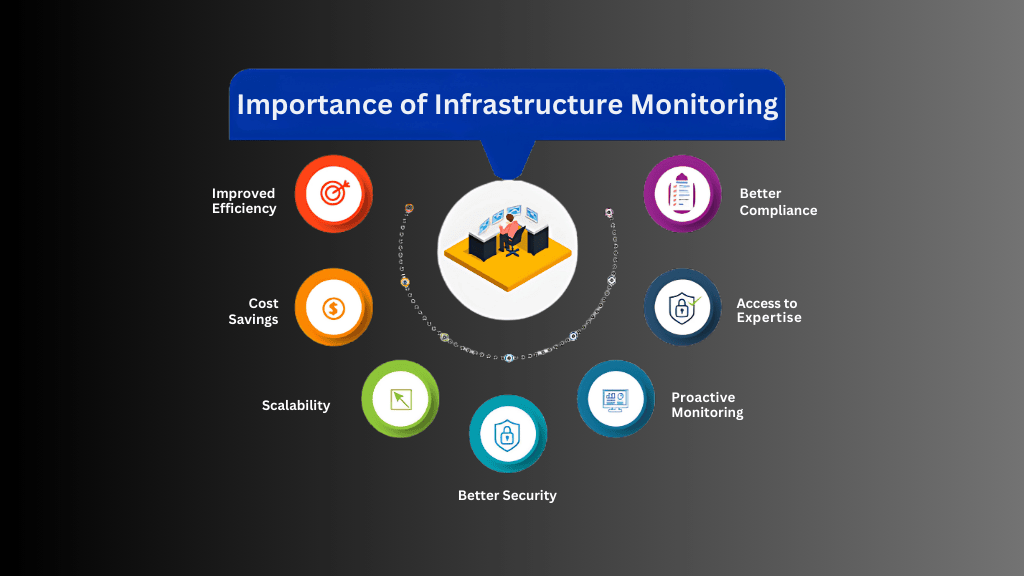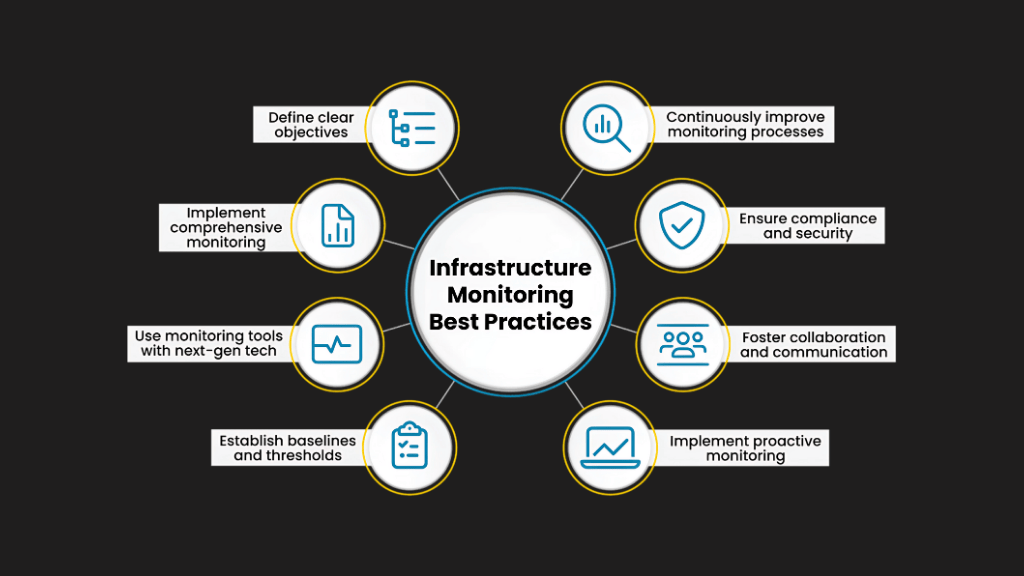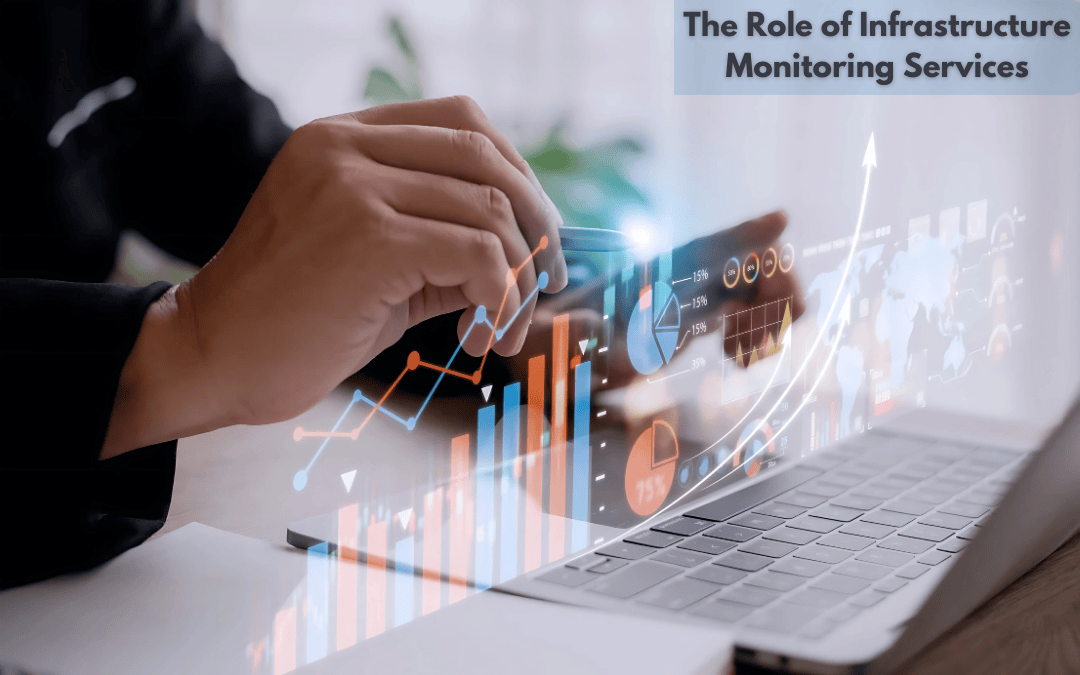In today’s hyper-connected world, a strong and reliable IT infrastructure is essential for business success. With the ever-increasing reliance on technology, downtime can prove to be extremely costly. This is where infrastructure monitoring services come into play, providing businesses with the tools and insights needed to proactively manage and optimize their IT environments.
From data centers to networks, applications to servers, infrastructure monitoring services offer real-time visibility into the performance and health of your systems. By constantly monitoring various metrics, such as response times, traffic patterns, and resource utilization, these services enable businesses to identify and address potential issues before they impact operations. This proactive approach not only helps minimize downtime but also enhances the overall performance and efficiency of the IT infrastructure.
Furthermore, infrastructure monitoring services offer valuable insights and analytics that can inform strategic decisions and drive continuous improvement. By analyzing trends and patterns, businesses can identify areas for optimization and resource allocation, ultimately boosting productivity and maximizing return on investment.
In conclusion, investing in infrastructure monitoring services is a vital step in unlocking business success in today’s digital age. By ensuring the reliability and optimal performance of your IT infrastructure, these services empower you to stay ahead of the competition and deliver exceptional experiences to customers.
Importance of infrastructure monitoring for businesses

In the rapidly evolving landscape of modern business, the significance of infrastructure monitoring cannot be overstated. Businesses today rely heavily on their IT infrastructure, which includes servers, networks, databases, and applications. Any interruption in these systems can lead to significant financial losses, reduced productivity, and damage to reputation. Infrastructure monitoring serves as a crucial safeguard, allowing organizations to maintain operational continuity and ensure their technological assets are functioning optimally. By keeping a close eye on system performance, businesses can avert potential issues before they escalate into major problems.
Moreover, infrastructure monitoring plays a vital role in enhancing decision-making processes. With real-time data at their disposal, IT teams can make informed choices regarding resource allocation, system upgrades, and capacity planning. This proactive approach not only saves time and money but also ensures that businesses can adapt swiftly to changing market demands. As organizations increasingly embrace digital transformation, the need for robust monitoring solutions becomes even more pressing. Companies that prioritize infrastructure monitoring are better positioned to leverage technology as a strategic asset rather than a mere support function.
Additionally, infrastructure monitoring fosters a culture of accountability and continuous improvement within organizations. By providing teams with visibility into system performance and end user experience, businesses can identify areas for enhancement. This analytical approach encourages teams to set performance benchmarks and strive for excellence, ultimately elevating overall service quality. Furthermore, with a strong monitoring framework in place, organizations can demonstrate compliance with industry standards and regulations, thereby building trust with stakeholders and customers alike.
Key features and benefits of infrastructure monitoring services
Infrastructure monitoring services come equipped with a host of features designed to provide comprehensive oversight of IT environments. One of the critical features is real-time monitoring, which enables organizations to track key metrics such as uptime, response times, and resource utilization. This feature ensures that any anomalies or performance degradation are identified immediately, allowing for swift remediation. Additionally, advanced alerting mechanisms notify IT teams of potential issues before they impact business operations, facilitating a proactive maintenance approach.
Another essential feature of these services is the capability to generate detailed reports and analytics. By compiling data over time, organizations can gain insights into usage patterns, trends, and system health. These analytics can inform strategic decisions, such as when to scale infrastructure or invest in new technologies. Additionally, the visualization tools offered by many monitoring solutions help teams understand complex data sets, making it easier to identify correlations and anomalies that may not be immediately apparent.
One of the most significant benefits of infrastructure monitoring is the enhancement of overall system reliability. By continuously overseeing infrastructure components, organizations can reduce the likelihood of unexpected downtime and service disruptions. This reliability not only improves internal productivity but also enhances customer satisfaction, as clients experience fewer interruptions in service. Moreover, with improved uptime and performance, businesses can capitalize on opportunities for growth and innovation, while also maintaining a competitive edge in their respective markets.
Common challenges in infrastructure monitoring
Despite its importance, businesses often encounter several challenges when implementing infrastructure monitoring solutions. One of the primary challenges is the sheer complexity of modern IT environments. As organizations adopt a diverse array of technologies, including cloud services, on-premises systems, and hybrid solutions, the task of monitoring all these components becomes increasingly complicated. This complexity can lead to gaps in visibility, where critical systems might not be adequately monitored, resulting in undetected issues that can hinder performance.
Another significant challenge is the overwhelming amount of data generated by monitoring tools. While having access to extensive data can be beneficial, it can also become a double-edged sword. IT teams may struggle to sift through mountains of information to identify actionable insights. Without proper filtering and prioritization of alerts, teams may experience alert fatigue, leading to important issues being overlooked. This challenge emphasizes the need for intelligent monitoring solutions that can effectively analyze data and highlight key metrics that require immediate attention.
Additionally, many organizations face resistance to change when it comes to adopting new monitoring practices. Employees may be accustomed to traditional methods of managing IT infrastructure and may be hesitant to embrace automated monitoring solutions. Overcoming this resistance often requires a cultural shift within the organization, where stakeholders understand the value and necessity of real-time monitoring. Providing adequate training and support can help ease this transition, fostering an environment where the benefits of monitoring are recognized and embraced by all team members.
Best practices for implementing infrastructure monitoring

Implementing infrastructure monitoring effectively requires careful planning and execution. One of the best practices is to define clear monitoring objectives that align with business goals. Organizations should identify what they hope to achieve through monitoring, whether it’s improving uptime, enhancing performance, or optimizing resource utilization. Establishing these goals provides a framework for selecting the right monitoring tools and metrics to track. Additionally, involving cross-functional teams in this process ensures that all relevant perspectives are considered, leading to a more comprehensive monitoring strategy.
Another essential best practice is to prioritize the critical components of the IT infrastructure that require monitoring. Not all systems are created equal, and certain applications or services may be more vital to business operations than others. By focusing on these critical elements, organizations can allocate their monitoring resources more effectively and ensure that any potential issues are addressed promptly. This targeted approach not only optimizes resource utilization but also enhances overall system reliability.
Moreover, organizations should regularly review and refine their monitoring strategies based on evolving business needs and technological advancements. As IT environments change, the monitoring tools and metrics in place may need to be adjusted accordingly. Conducting periodic assessments of monitoring effectiveness can help identify any gaps or areas for improvement. This iterative approach fosters a culture of continuous improvement, ensuring that the monitoring framework remains relevant and capable of supporting business objectives in the long run.
Choosing the right infrastructure monitoring service provider

Selecting the appropriate infrastructure monitoring service provider is a critical step in ensuring the success of monitoring initiatives. One of the first considerations is the provider’s experience and expertise in the industry. Organizations should look for vendors that have a proven track record of delivering monitoring solutions tailored to their specific needs. Evaluating case studies and customer testimonials can provide valuable insights into the provider’s capabilities and performance.
In addition to experience, organizations should assess the features and functionalities offered by potential service providers. Different monitoring solutions come equipped with varying capabilities, such as real-time analytics, alerting mechanisms, and reporting tools. It’s essential to choose a provider that aligns with the organization’s monitoring objectives and offers a user-friendly interface for ease of use. Furthermore, scalability is a crucial factor; as businesses grow, their monitoring needs may evolve, and the chosen provider should be able to accommodate these changes seamlessly.
Lastly, organizations should consider the level of customer support and service provided by the monitoring service provider. Effective communication and support are paramount, especially during implementation and when addressing any issues that may arise. A provider that offers comprehensive training resources, responsive customer service, and ongoing support can significantly enhance the overall monitoring experience. By thoroughly evaluating these factors, organizations can make an informed decision and select a monitoring service provider that best meets their needs and contributes to their long-term success.
Case studies showcasing the impact of infrastructure monitoring on businesses
Numerous organizations have successfully leveraged infrastructure monitoring services to enhance their operations and achieve significant outcomes. One notable case is a large e-commerce company that experienced frequent downtime due to infrastructure failures during peak shopping seasons. By implementing a comprehensive monitoring solution, the company gained real-time visibility into its systems, enabling the IT team to proactively identify and resolve issues before they could impact customers. As a result, the company reported a 30% reduction in downtime and an increase in customer satisfaction, leading to higher revenue during critical sales periods.
Another compelling example is a financial institution that faced challenges in meeting regulatory compliance requirements. By utilizing infrastructure monitoring services, the organization was able to maintain continuous oversight of its systems, ensuring that all components were functioning optimally and securely. The monitoring solution provided detailed reporting and analytics, allowing the institution to demonstrate compliance with industry regulations efficiently. This not only mitigated potential penalties but also bolstered the organization’s reputation as a reliable financial service provider.
Lastly, a healthcare organization implemented infrastructure monitoring to enhance the performance of its patient management system. With monitoring in place, the IT team could quickly identify performance bottlenecks and optimize resources accordingly. This proactive approach resulted in a significant improvement in system response times, leading to more efficient patient care and streamlined operations. The healthcare organization reported an increase in staff productivity and a reduction in patient wait times, demonstrating the profound impact of effective infrastructure monitoring on service delivery in the healthcare sector.
Future trends in infrastructure monitoring
As technology continues to evolve, so too will the landscape of infrastructure monitoring. One prominent trend is the increased adoption of artificial intelligence (AI) and machine learning (ML) in monitoring solutions. These technologies enable systems to analyze vast amounts of data and identify patterns, allowing for more accurate predictions of potential issues. AI-driven monitoring can automate routine tasks, such as alerting and reporting, freeing up IT teams to focus on more strategic initiatives. As organizations seek greater efficiency and cost-effectiveness, integrating AI into monitoring processes will become increasingly prevalent.
Another trend is the shift towards cloud-based monitoring solutions. As businesses increasingly migrate their operations to the cloud, traditional on-premises monitoring tools may struggle to keep pace with the dynamic nature of cloud environments. Cloud based network monitoring services offer enhanced scalability and flexibility, allowing organizations to monitor hybrid and multi-cloud infrastructures seamlessly. This trend will likely accelerate as businesses continue to embrace digital transformation and seek solutions that can adapt to their changing needs.
Additionally, the rise of the Internet of Things (IoT) will significantly impact infrastructure monitoring practices. With the proliferation of IoT devices, organizations must find ways to monitor not only traditional IT assets but also a growing number of connected devices. This shift will necessitate the development of specialized monitoring solutions that can accommodate the unique challenges posed by IoT environments. As businesses expand their use of IoT technologies, the demand for comprehensive monitoring tools that can provide visibility across all connected assets will continue to rise.
Cost considerations for infrastructure monitoring services

When evaluating infrastructure monitoring services, cost is a critical factor that organizations must consider. It’s essential to understand the pricing models offered by different service providers, as these can vary significantly. Some providers may offer subscription-based pricing, where businesses pay a monthly or annual fee based on the number of monitored assets or users. Others may employ a pay-as-you-go model, allowing organizations to pay only for the resources they use. Evaluating these pricing structures in relation to the organization’s budget and projected growth is vital for making an informed decision.
Furthermore, organizations should take into account the potential return on investment (ROI) that infrastructure monitoring services can deliver. While there may be upfront costs associated with implementing monitoring solutions, the long-term benefits often outweigh these initial expenses. By reducing downtime, improving system performance, and enhancing operational efficiency, monitoring services can contribute to significant cost savings over time. Conducting a cost-benefit analysis can help organizations illustrate the value of investing in monitoring solutions and justify the expense.
Lastly, ongoing maintenance and support costs should also be factored into the overall budget for infrastructure monitoring. Service providers may offer varying levels of support, which can impact the total cost of ownership. Organizations should clarify what support services are included in the pricing and any additional costs that may arise for upgrades, training, or technical assistance. By thoroughly assessing all cost considerations, businesses can ensure that they select a monitoring service that aligns with their financial objectives while delivering the necessary performance and reliability.
Conclusion: Leveraging infrastructure monitoring for business success
In conclusion, infrastructure monitoring services play an indispensable role in supporting business success in today’s technology-driven landscape. By maintaining a vigilant watch over IT environments, organizations can prevent downtime, enhance performance, and make data-driven decisions that align with their strategic goals. The benefits of implementing robust monitoring solutions extend far beyond mere operational efficiency; they also foster a culture of accountability, innovation, and continuous improvement.
As businesses navigate the complexities of modern IT infrastructures, adopting best practices for monitoring implementation and choosing the right service provider will be paramount. By staying attuned to industry trends and advancements, organizations can ensure that their monitoring strategies remain relevant and effective. Ultimately, investing in infrastructure monitoring services is not just a tactical decision; it is a strategic imperative that empowers businesses to thrive in an increasingly competitive marketplace.
By unlocking the potential of infrastructure monitoring, organizations can not only enhance their operational capabilities but also deliver exceptional experiences to their customers. In an era where technology is intertwined with every aspect of business, leveraging monitoring services is a crucial step toward achieving lasting success and sustainability.

